Analyzing Toys 'R' Us' International Business Operations and Expansion
VerifiedAdded on 2023/06/10
|5
|1117
|366
Report
AI Summary
This report provides an analysis of Toys 'R' Us' international business operations. It begins by identifying the firm-specific advantages that contributed to its success in international markets, such as its brand recognition and discount formula. The report then explores the cultural and political barriers encountered by Toys 'R' Us when entering overseas markets, specifically referencing the challenges faced in Germany and Japan. It further examines the reasons behind Toys 'R' Us' greater success in Japan compared to Germany, highlighting the adaptability to local business models. Finally, the report considers the potential for Toys 'R' Us to succeed in a new country, acknowledging the need to address potential market-specific challenges and adapt to local business practices. The analysis draws upon academic sources to support its claims.
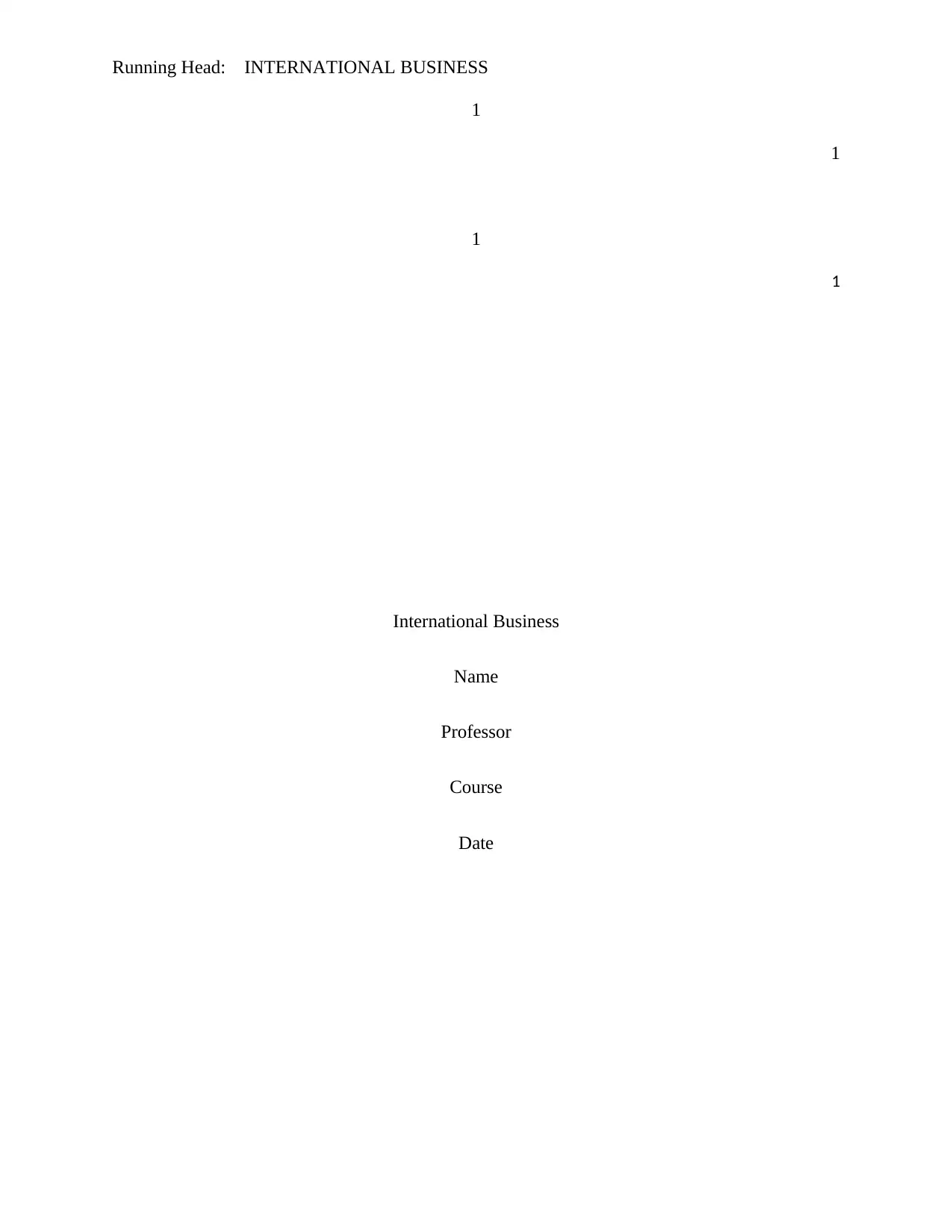
Running Head: INTERNATIONAL BUSINESS
1
1
1
1
International Business
Name
Professor
Course
Date
1
1
1
1
International Business
Name
Professor
Course
Date
Paraphrase This Document
Need a fresh take? Get an instant paraphrase of this document with our AI Paraphraser
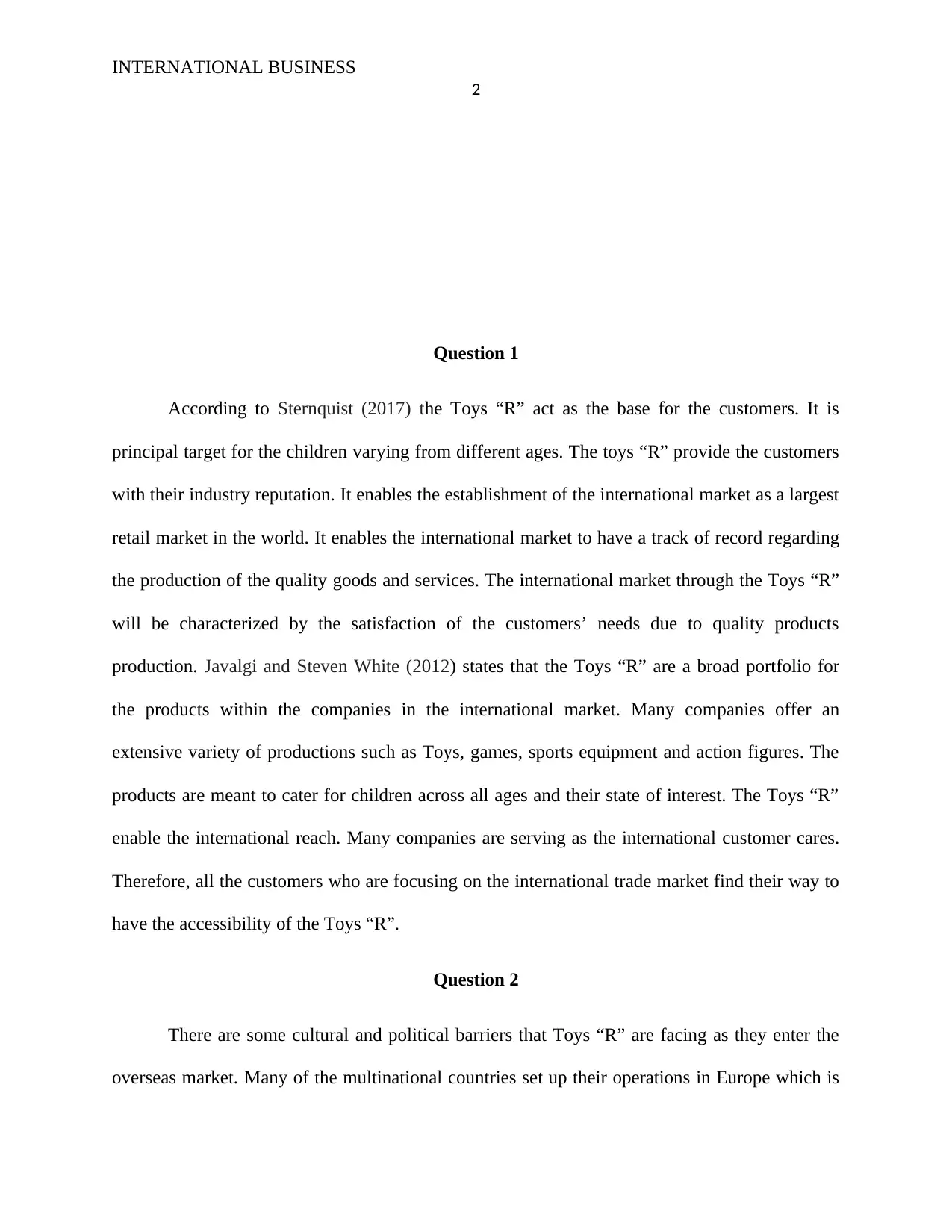
INTERNATIONAL BUSINESS
2
Question 1
According to Sternquist (2017) the Toys “R” act as the base for the customers. It is
principal target for the children varying from different ages. The toys “R” provide the customers
with their industry reputation. It enables the establishment of the international market as a largest
retail market in the world. It enables the international market to have a track of record regarding
the production of the quality goods and services. The international market through the Toys “R”
will be characterized by the satisfaction of the customers’ needs due to quality products
production. Javalgi and Steven White (2012) states that the Toys “R” are a broad portfolio for
the products within the companies in the international market. Many companies offer an
extensive variety of productions such as Toys, games, sports equipment and action figures. The
products are meant to cater for children across all ages and their state of interest. The Toys “R”
enable the international reach. Many companies are serving as the international customer cares.
Therefore, all the customers who are focusing on the international trade market find their way to
have the accessibility of the Toys “R”.
Question 2
There are some cultural and political barriers that Toys “R” are facing as they enter the
overseas market. Many of the multinational countries set up their operations in Europe which is
2
Question 1
According to Sternquist (2017) the Toys “R” act as the base for the customers. It is
principal target for the children varying from different ages. The toys “R” provide the customers
with their industry reputation. It enables the establishment of the international market as a largest
retail market in the world. It enables the international market to have a track of record regarding
the production of the quality goods and services. The international market through the Toys “R”
will be characterized by the satisfaction of the customers’ needs due to quality products
production. Javalgi and Steven White (2012) states that the Toys “R” are a broad portfolio for
the products within the companies in the international market. Many companies offer an
extensive variety of productions such as Toys, games, sports equipment and action figures. The
products are meant to cater for children across all ages and their state of interest. The Toys “R”
enable the international reach. Many companies are serving as the international customer cares.
Therefore, all the customers who are focusing on the international trade market find their way to
have the accessibility of the Toys “R”.
Question 2
There are some cultural and political barriers that Toys “R” are facing as they enter the
overseas market. Many of the multinational countries set up their operations in Europe which is
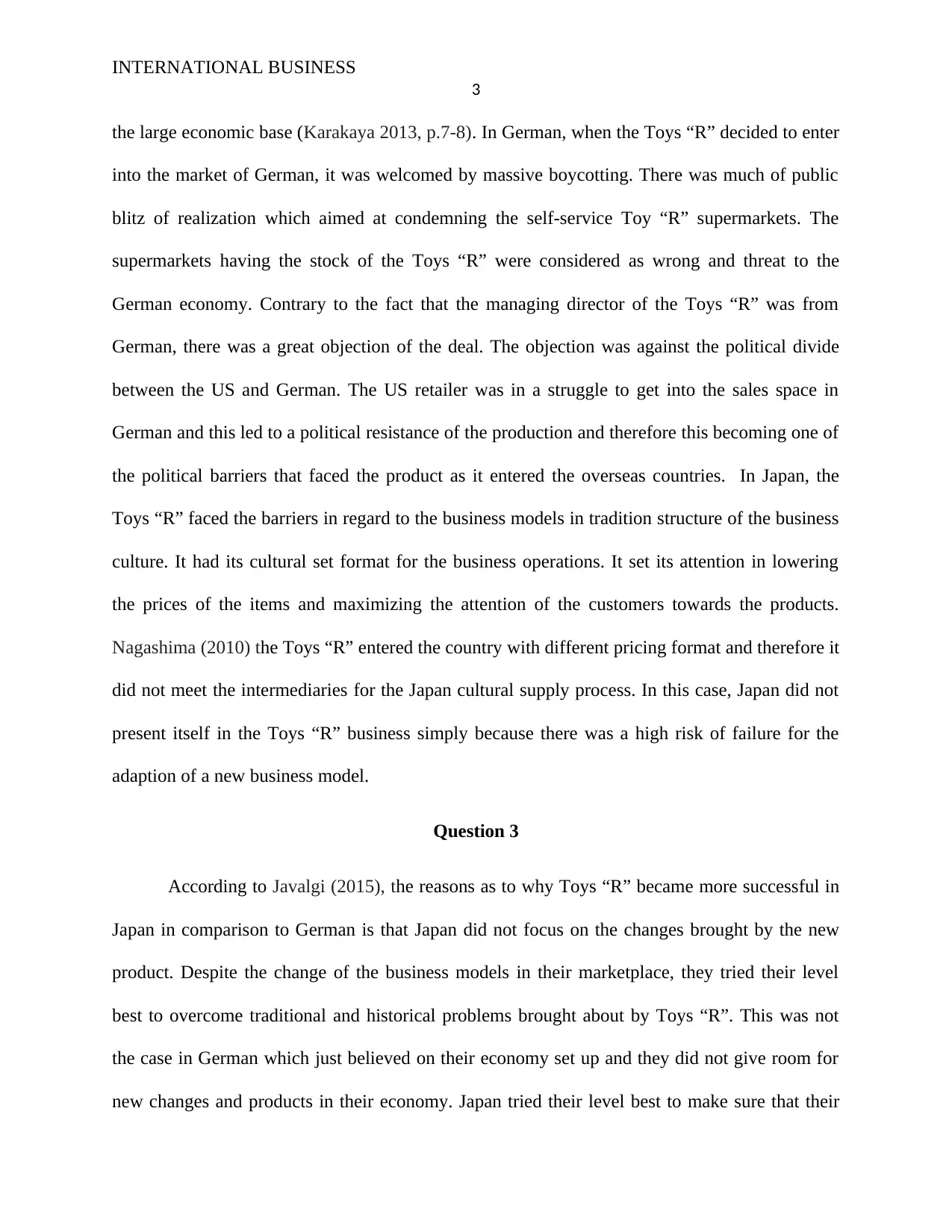
INTERNATIONAL BUSINESS
3
the large economic base (Karakaya 2013, p.7-8). In German, when the Toys “R” decided to enter
into the market of German, it was welcomed by massive boycotting. There was much of public
blitz of realization which aimed at condemning the self-service Toy “R” supermarkets. The
supermarkets having the stock of the Toys “R” were considered as wrong and threat to the
German economy. Contrary to the fact that the managing director of the Toys “R” was from
German, there was a great objection of the deal. The objection was against the political divide
between the US and German. The US retailer was in a struggle to get into the sales space in
German and this led to a political resistance of the production and therefore this becoming one of
the political barriers that faced the product as it entered the overseas countries. In Japan, the
Toys “R” faced the barriers in regard to the business models in tradition structure of the business
culture. It had its cultural set format for the business operations. It set its attention in lowering
the prices of the items and maximizing the attention of the customers towards the products.
Nagashima (2010) the Toys “R” entered the country with different pricing format and therefore it
did not meet the intermediaries for the Japan cultural supply process. In this case, Japan did not
present itself in the Toys “R” business simply because there was a high risk of failure for the
adaption of a new business model.
Question 3
According to Javalgi (2015), the reasons as to why Toys “R” became more successful in
Japan in comparison to German is that Japan did not focus on the changes brought by the new
product. Despite the change of the business models in their marketplace, they tried their level
best to overcome traditional and historical problems brought about by Toys “R”. This was not
the case in German which just believed on their economy set up and they did not give room for
new changes and products in their economy. Japan tried their level best to make sure that their
3
the large economic base (Karakaya 2013, p.7-8). In German, when the Toys “R” decided to enter
into the market of German, it was welcomed by massive boycotting. There was much of public
blitz of realization which aimed at condemning the self-service Toy “R” supermarkets. The
supermarkets having the stock of the Toys “R” were considered as wrong and threat to the
German economy. Contrary to the fact that the managing director of the Toys “R” was from
German, there was a great objection of the deal. The objection was against the political divide
between the US and German. The US retailer was in a struggle to get into the sales space in
German and this led to a political resistance of the production and therefore this becoming one of
the political barriers that faced the product as it entered the overseas countries. In Japan, the
Toys “R” faced the barriers in regard to the business models in tradition structure of the business
culture. It had its cultural set format for the business operations. It set its attention in lowering
the prices of the items and maximizing the attention of the customers towards the products.
Nagashima (2010) the Toys “R” entered the country with different pricing format and therefore it
did not meet the intermediaries for the Japan cultural supply process. In this case, Japan did not
present itself in the Toys “R” business simply because there was a high risk of failure for the
adaption of a new business model.
Question 3
According to Javalgi (2015), the reasons as to why Toys “R” became more successful in
Japan in comparison to German is that Japan did not focus on the changes brought by the new
product. Despite the change of the business models in their marketplace, they tried their level
best to overcome traditional and historical problems brought about by Toys “R”. This was not
the case in German which just believed on their economy set up and they did not give room for
new changes and products in their economy. Japan tried their level best to make sure that their
⊘ This is a preview!⊘
Do you want full access?
Subscribe today to unlock all pages.

Trusted by 1+ million students worldwide
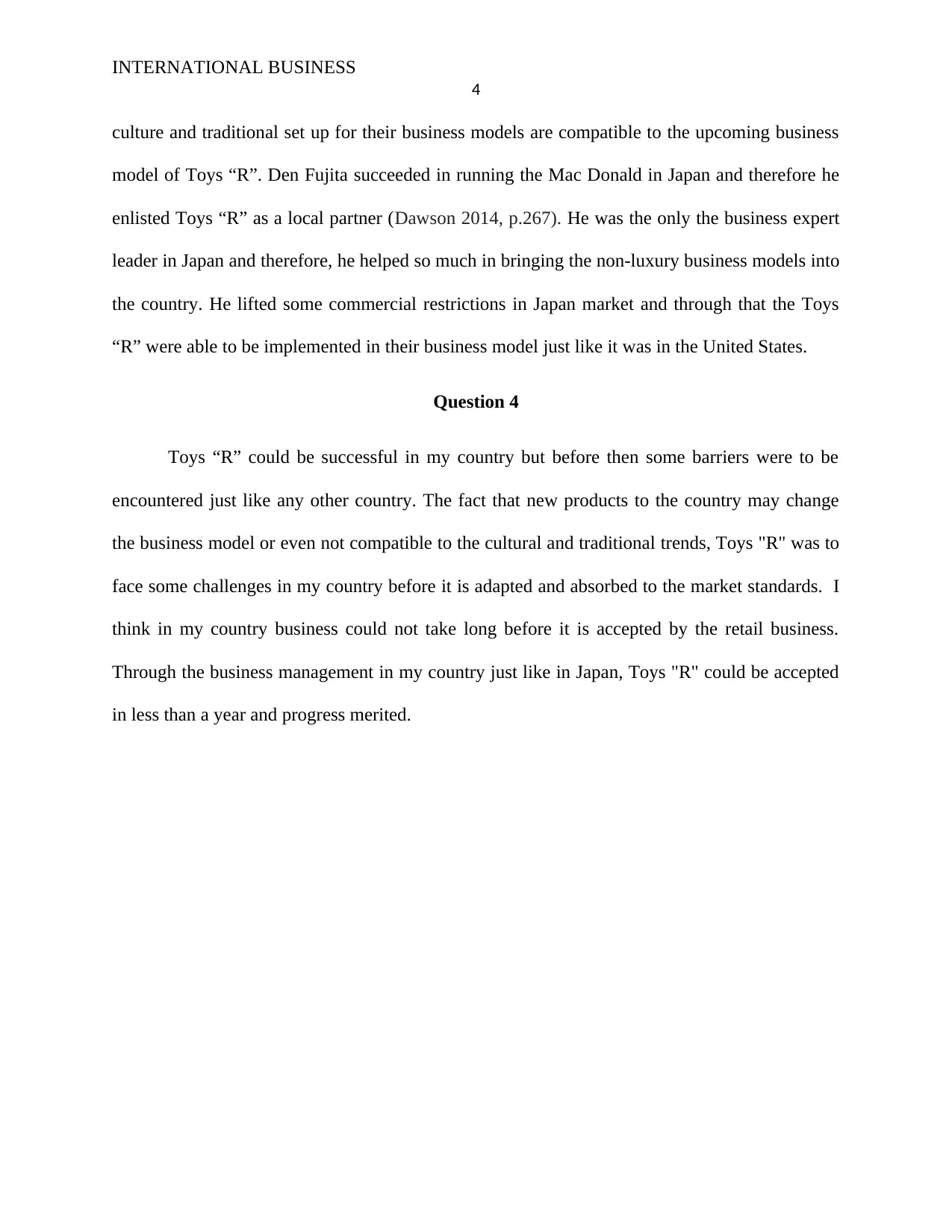
INTERNATIONAL BUSINESS
4
culture and traditional set up for their business models are compatible to the upcoming business
model of Toys “R”. Den Fujita succeeded in running the Mac Donald in Japan and therefore he
enlisted Toys “R” as a local partner (Dawson 2014, p.267). He was the only the business expert
leader in Japan and therefore, he helped so much in bringing the non-luxury business models into
the country. He lifted some commercial restrictions in Japan market and through that the Toys
“R” were able to be implemented in their business model just like it was in the United States.
Question 4
Toys “R” could be successful in my country but before then some barriers were to be
encountered just like any other country. The fact that new products to the country may change
the business model or even not compatible to the cultural and traditional trends, Toys "R" was to
face some challenges in my country before it is adapted and absorbed to the market standards. I
think in my country business could not take long before it is accepted by the retail business.
Through the business management in my country just like in Japan, Toys "R" could be accepted
in less than a year and progress merited.
4
culture and traditional set up for their business models are compatible to the upcoming business
model of Toys “R”. Den Fujita succeeded in running the Mac Donald in Japan and therefore he
enlisted Toys “R” as a local partner (Dawson 2014, p.267). He was the only the business expert
leader in Japan and therefore, he helped so much in bringing the non-luxury business models into
the country. He lifted some commercial restrictions in Japan market and through that the Toys
“R” were able to be implemented in their business model just like it was in the United States.
Question 4
Toys “R” could be successful in my country but before then some barriers were to be
encountered just like any other country. The fact that new products to the country may change
the business model or even not compatible to the cultural and traditional trends, Toys "R" was to
face some challenges in my country before it is adapted and absorbed to the market standards. I
think in my country business could not take long before it is accepted by the retail business.
Through the business management in my country just like in Japan, Toys "R" could be accepted
in less than a year and progress merited.
Paraphrase This Document
Need a fresh take? Get an instant paraphrase of this document with our AI Paraphraser
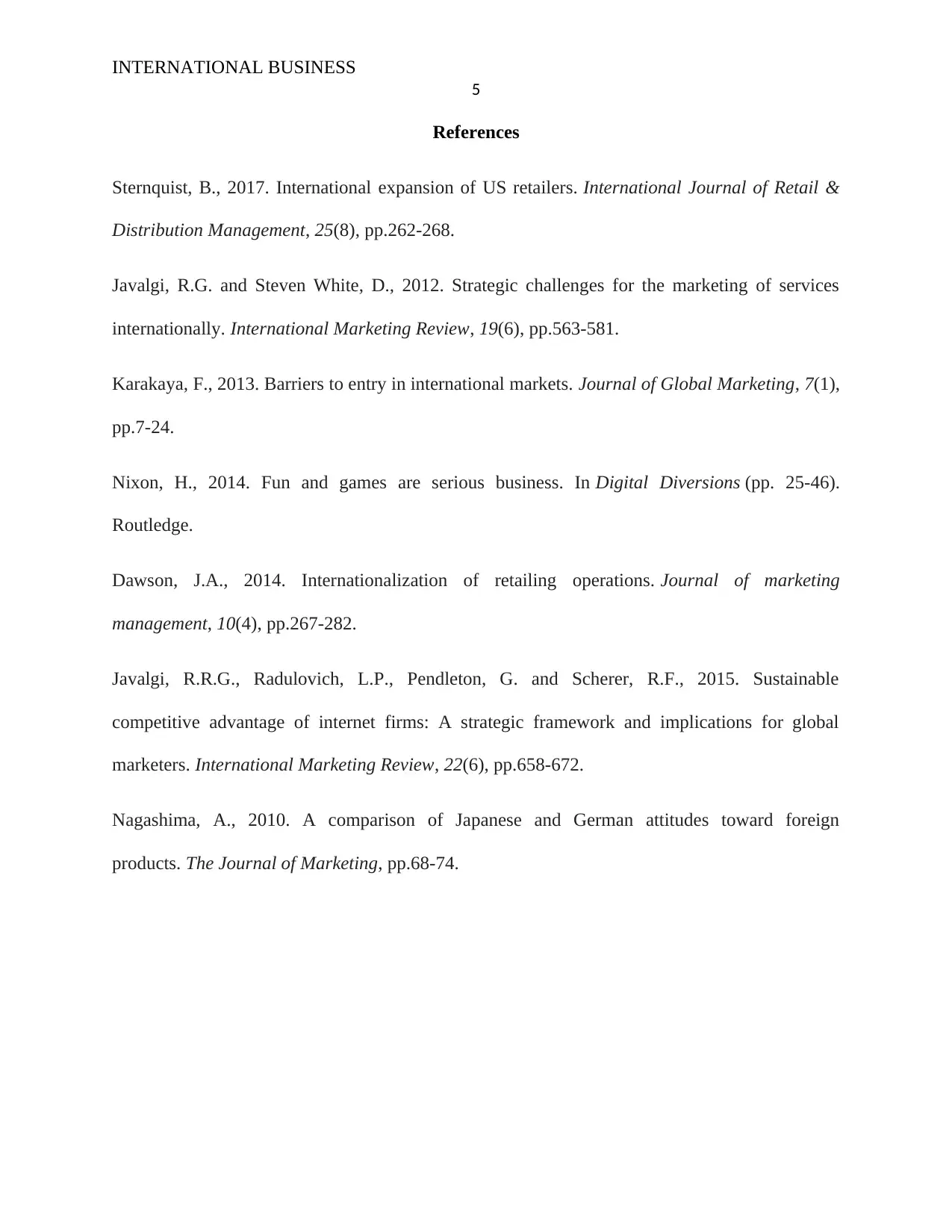
INTERNATIONAL BUSINESS
5
References
Sternquist, B., 2017. International expansion of US retailers. International Journal of Retail &
Distribution Management, 25(8), pp.262-268.
Javalgi, R.G. and Steven White, D., 2012. Strategic challenges for the marketing of services
internationally. International Marketing Review, 19(6), pp.563-581.
Karakaya, F., 2013. Barriers to entry in international markets. Journal of Global Marketing, 7(1),
pp.7-24.
Nixon, H., 2014. Fun and games are serious business. In Digital Diversions (pp. 25-46).
Routledge.
Dawson, J.A., 2014. Internationalization of retailing operations. Journal of marketing
management, 10(4), pp.267-282.
Javalgi, R.R.G., Radulovich, L.P., Pendleton, G. and Scherer, R.F., 2015. Sustainable
competitive advantage of internet firms: A strategic framework and implications for global
marketers. International Marketing Review, 22(6), pp.658-672.
Nagashima, A., 2010. A comparison of Japanese and German attitudes toward foreign
products. The Journal of Marketing, pp.68-74.
5
References
Sternquist, B., 2017. International expansion of US retailers. International Journal of Retail &
Distribution Management, 25(8), pp.262-268.
Javalgi, R.G. and Steven White, D., 2012. Strategic challenges for the marketing of services
internationally. International Marketing Review, 19(6), pp.563-581.
Karakaya, F., 2013. Barriers to entry in international markets. Journal of Global Marketing, 7(1),
pp.7-24.
Nixon, H., 2014. Fun and games are serious business. In Digital Diversions (pp. 25-46).
Routledge.
Dawson, J.A., 2014. Internationalization of retailing operations. Journal of marketing
management, 10(4), pp.267-282.
Javalgi, R.R.G., Radulovich, L.P., Pendleton, G. and Scherer, R.F., 2015. Sustainable
competitive advantage of internet firms: A strategic framework and implications for global
marketers. International Marketing Review, 22(6), pp.658-672.
Nagashima, A., 2010. A comparison of Japanese and German attitudes toward foreign
products. The Journal of Marketing, pp.68-74.
1 out of 5
Related Documents
Your All-in-One AI-Powered Toolkit for Academic Success.
+13062052269
info@desklib.com
Available 24*7 on WhatsApp / Email
![[object Object]](/_next/static/media/star-bottom.7253800d.svg)
Unlock your academic potential
Copyright © 2020–2025 A2Z Services. All Rights Reserved. Developed and managed by ZUCOL.




